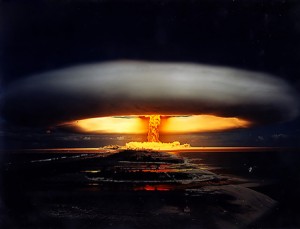Nuclear Pakistan
 Pakistan’s nuclear calculus has been the subject of much scrutiny because its government is unstable, its population is volatile, and its nuclear weapons program is the fastest expanding on Earth. Pakistani officials have maintained that their nuclear program’s only utility is countering the nuclear and conventional military threat posed by India, but Pakistan’s nuclear program is not lagging dangerously behind India. The Federation of American Scientists (FAS) estimates that Pakistan has a stockpile of 110 to 130 nuclear warheads while India sports a stockpile of 110 to 120 nuclear warheads; Pakistan may have already surpassed India in its nuclear warhead buildup.
Pakistan’s nuclear calculus has been the subject of much scrutiny because its government is unstable, its population is volatile, and its nuclear weapons program is the fastest expanding on Earth. Pakistani officials have maintained that their nuclear program’s only utility is countering the nuclear and conventional military threat posed by India, but Pakistan’s nuclear program is not lagging dangerously behind India. The Federation of American Scientists (FAS) estimates that Pakistan has a stockpile of 110 to 130 nuclear warheads while India sports a stockpile of 110 to 120 nuclear warheads; Pakistan may have already surpassed India in its nuclear warhead buildup.
Further complicating the strategic calculus on both sides, Pakistan’s Foreign Secretary Aizaz Chaudhry announced on October 20, 2015, that Pakistan has created low-yield nuclear weapons. These weapons intend to provide an alternative to the most extreme nuclear holocaust and further deter India from using its superior conventional forces against Pakistan. The advantages and destabilizing nature of low-yield nuclear weapons have been debated in the U.S. for some time, but so far there has been no great push to integrate them into the U.S. arsenal. The U.S. Congress prohibited exploratory research of low-yield nuclear weapons in the Defense Authorization Act of 1994, with the Spratt-Furse law, but the 2004 Defense Authorization Act reversed this law to allow “critical research and development for low-yield nuclear weapons.” The logic behind Congress’s 1994 decision described “low-yield nuclear weapons [as] blurr[ing] the distinction between nuclear and conventional war.”
The blurring of lines between nuclear and conventional war encourages the use of low-yield nuclear weapons, which riddles any military activity along the India-Pakistan border with greater uncertainty. The threat of nuclear confrontation between Pakistan and India was nearly realized in the 1999 Kargil conflict, which lasted only from May 8th until July 14th. If a low-yield nuclear weapon were to be detonated, it would likely be due in part to the conflict surrounding control of Kashmir – which is where Kargil district resides.
 Former National Security Advisor to President Clinton, Samuel Berger, passed away on December 2, 2015, and new evidence about the nuclear threat of the Kargil conflict was revealed in an obituary written for Mr. Berger by a former CIA analyst and current Brookings fellow Bruce Riedel. In the obituary, Mr. Riedel describes the morning of July 4, 1999: Clinton had just received his classified daily briefing detailing the compelling evidence that “Pakistan was preparing its nuclear weapons for deployment and possible use,” Prime Minister Sharif was waiting across the street at Blair House to meet with Clinton, and Clinton’s national security team was convening in the Oval Office. Berger strongly advised Clinton to tell Sharif to pull out of Kargil, so that the situation would not escalate dramatically.
Former National Security Advisor to President Clinton, Samuel Berger, passed away on December 2, 2015, and new evidence about the nuclear threat of the Kargil conflict was revealed in an obituary written for Mr. Berger by a former CIA analyst and current Brookings fellow Bruce Riedel. In the obituary, Mr. Riedel describes the morning of July 4, 1999: Clinton had just received his classified daily briefing detailing the compelling evidence that “Pakistan was preparing its nuclear weapons for deployment and possible use,” Prime Minister Sharif was waiting across the street at Blair House to meet with Clinton, and Clinton’s national security team was convening in the Oval Office. Berger strongly advised Clinton to tell Sharif to pull out of Kargil, so that the situation would not escalate dramatically.
The advice from Berger was enacted and the Kargil conflict essentially ended on July 14th when Pakistan retracted its forces and both sides terminated their military operations. While this was a diplomatic success, there is little evidence to believe that diplomacy will reign supreme if nuclear weapons continue to be incorporated into Pakistan’s weapons arsenal. Most threatening are the low-yield nuclear weapons, which some might conclude can be used sporadically without inflaming an all-out nuclear response from India.
The U.S. should address the tense and unstable relationship between Pakistan and India by creating an international coalition that will assist in the negotiating process, and provide incentives for any progress made.
 The first and most important step is to eliminate low-yield nuclear weapons from the equation because they walk the line of nuclear and conventional warfare. It is no secret that India and Pakistan are the states most likely to use their nuclear weapons against each other. Foreign Secretary Chaudhry articulated on the day of his announcement of Pakistan’s creation of low-yield nuclear weapons, “Our nuclear program is one dimensional: stopping Indian aggression before it happens. It is not for starting a war. It is for deterrence.”
The first and most important step is to eliminate low-yield nuclear weapons from the equation because they walk the line of nuclear and conventional warfare. It is no secret that India and Pakistan are the states most likely to use their nuclear weapons against each other. Foreign Secretary Chaudhry articulated on the day of his announcement of Pakistan’s creation of low-yield nuclear weapons, “Our nuclear program is one dimensional: stopping Indian aggression before it happens. It is not for starting a war. It is for deterrence.”
India has already taken a huge step in adopting “a no-first-use policy on nuclear weapons,” but the same policy has not been declared by Pakistan. Solving India-Pakistan relations is not on the table but removing low-yield nuclear weapons from Pakistan’s arsenal is. An international coalition focused on this particular threat could assist in the negotiation of a reasonable agreement that would eliminate Pakistan’s low-yield nuclear weapons. What India or the international community could offer in exchange is not clear at this time, but enough international attention could bring Pakistan to the negotiating table.






